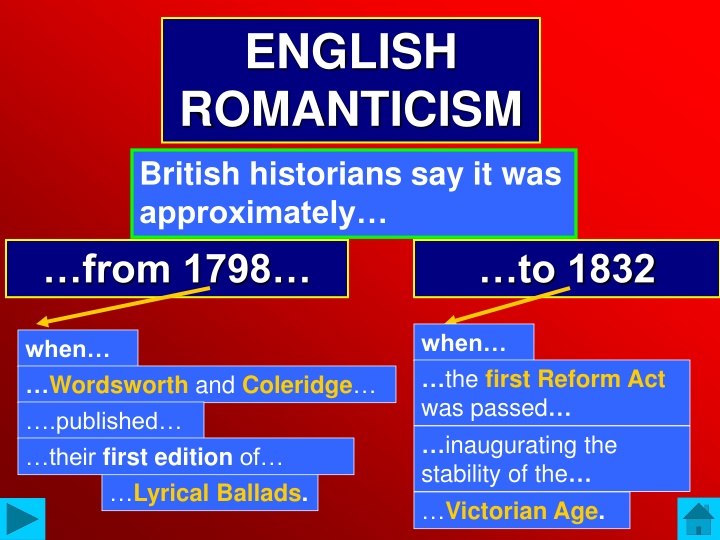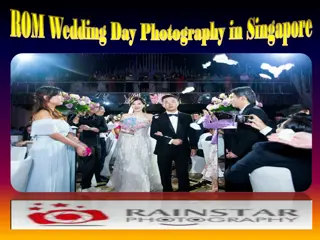
English Romanticism and the Impact of the Enlightenment Era
Explore the era of English Romanticism from 1798 to 1832, marked by key events like the French Revolution and Industrial Revolution. British historians highlight the influence of Wordsworth and Coleridge, the enthusiasm followed by disillusionment towards revolutions, social problems, state repression, and the limitations of reason. Discover how Romanticism emerged as a reaction championing emotions and imagination, challenging the constraints imposed by the Enlightenment ideals.
Uploaded on | 2 Views
Download Presentation

Please find below an Image/Link to download the presentation.
The content on the website is provided AS IS for your information and personal use only. It may not be sold, licensed, or shared on other websites without obtaining consent from the author. If you encounter any issues during the download, it is possible that the publisher has removed the file from their server.
You are allowed to download the files provided on this website for personal or commercial use, subject to the condition that they are used lawfully. All files are the property of their respective owners.
The content on the website is provided AS IS for your information and personal use only. It may not be sold, licensed, or shared on other websites without obtaining consent from the author.
E N D
Presentation Transcript
ENGLISH ROMANTICISM British historians say it was approximately from 1798 to 1832 when the first Reform Act was passed inaugurating the stability of the Victorian Age. when Wordsworth and Coleridge .published their first edition of Lyrical Ballads.
It was a .. period: turbulent Industrial Revolution American Revolution French Revolution Napoleonic Wars At the beginning of the FRENCH REVOLUTION, English Romantic writers were about it. enthusiastic Because they loved the .. of the FRENCH REVOLUTION ideals WHY? FREEDOM FRATERNITY EQUALITY
BUT LATER English Romantic writers became DISILLUSIONED with the violence of the period of TERROR the emergence of NAPOLEON http://t3.gstatic.com/images?q=tbn:ANd9GcRifEXEDzUjvpqRg1-Rq-2cCWW71s7cCES5i00DF0ts0U52rz3A http://t0.gstatic.com/images?q=tbn:ANd9GcQpmYlzp7zu5L8fNQV8KfskDAi6DxnRy4D7HrcpAtjazkj21HG6bA
IN ENGLAND THERE WERE MANY SOCIAL PROBLEMS no right to vote long hours of work terrible working conditions no trade unions low wages technological unemployment employment of children It led to LUDDISM machine-breaking in factories
DID THE STATE TRY TO SOLVE THESE SOCIAL PROBLEMS? NO The state s answer was . REPRESSION The most shocking episode was .The PETERLOO MASSACRE In 1819 soldiers killed 11 people during a peaceful public meeting
IN THIS HISTORICAL AND SOCIAL CONTEXT THE KEYWORD OF THE ENLIGHTENMENT: REASON proved powerless to solve the social evils of the time: the misery of industrialisation
AND ALSO FROM A LITERARY POINT OF VIEW . THE KEYWORD OF THE ENLIGHTENMENT: REASON had led to the repression of emotions and feelings REASON had become a mental prison
THEREFORE ROMANTICISM was the faith in REASON (the Enlightenment) a reaction AGAINST of the previous age THEREFORE ROMANTICISM was characterised by EMOTIONS the supremacy of FEELINGS IMAGINATION
WHAT WAS THE MAIN LITERARY GENRE IN ROMANTICISM? WHAT WAS THE BEST MEANS TO GIVE EXPRESSION TO FEELINGS AND IMAGINATION? POETRY
THE MAIN FEATURES OF ROMANTICISM: a growing interest in humble and everyday life nature and the countryside were exalted (in opposition to the industrial town) http://t1.gstatic.com/images?q=tbn:ANd9GcTpEnYvUQkhHz_A4_SVYTN3Mm_KSLH-3W-8tU5fJiW5GAFDIag4j8g9kcE http://t0.gstatic.com/images?q=tbn:ANd9GcSgeXHiEe0bn3psjOv92_g0D7uY6c9GvmTgsDiQ-QbBSSKSXbQe
THE MAIN FEATURES OF ROMANTICISM: a revival of interest in the Middle Ages, a new taste for the desolate, the love of ruins and graveyards (especially in the Gothic novel) http://t3.gstatic.com/images?q=tbn:ANd9GcTpEGE3WcWB3UQ0bbBxFB9o6oV3UCUq-YlL8k6Ze0H4GsTLQVp-HA http://t3.gstatic.com/images?q=tbn:ANd9GcSxFm2P_FoZhS8FAZlRJ_ZgrS8DNvMOBAC6iV8Tst26fH4vCYNgv_8KN38 http://t1.gstatic.com/images?q=tbn:ANd9GcQB2L-QEaBqzIHI9McWjHMTWsHHPZfEyhWDcE38dGh0RBkkz6mxd4flirU
THE MAIN FEATURES OF ROMANTICISM: the cult of the exotic the importance of imagination and childhood http://t2.gstatic.com/images?q=tbn:ANd9GcQtXGA05BMOWUl5KxrPzsw2VvofxishLuSGmH1sqnw8-6BvcSxi
THE MAIN FEATURES OF ROMANTICISM: individualism (man in the solitary state not corrupted by society) Rousseau the source of poetry is not in the outer world but in the poet s INNER FEELINGS
The great English Romantic poets are usually divided into two generations: The FIRST generation The SECOND generation The so-called LAKE POETS P.B. Shelley G.G. Byron J. Keats W. Wordsworth S. T. Coleridge














